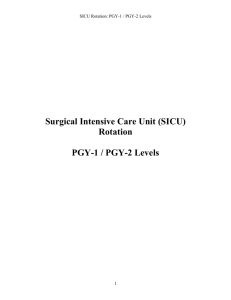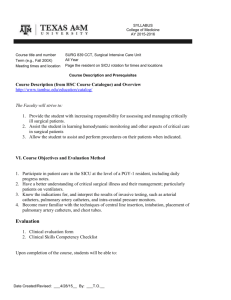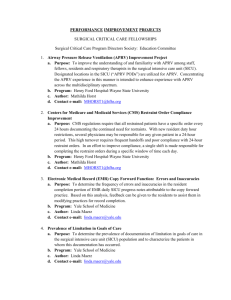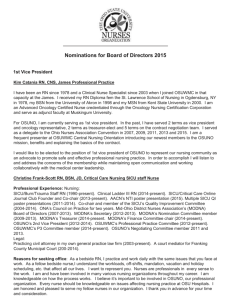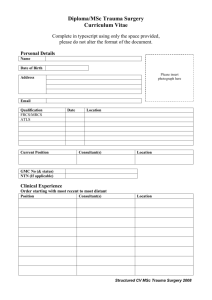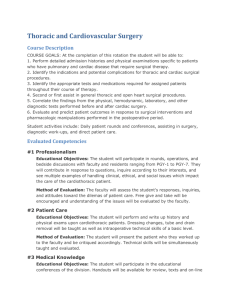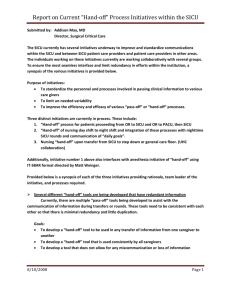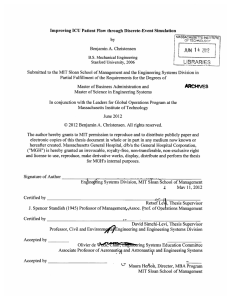SICU - Department of Anesthesiology
advertisement
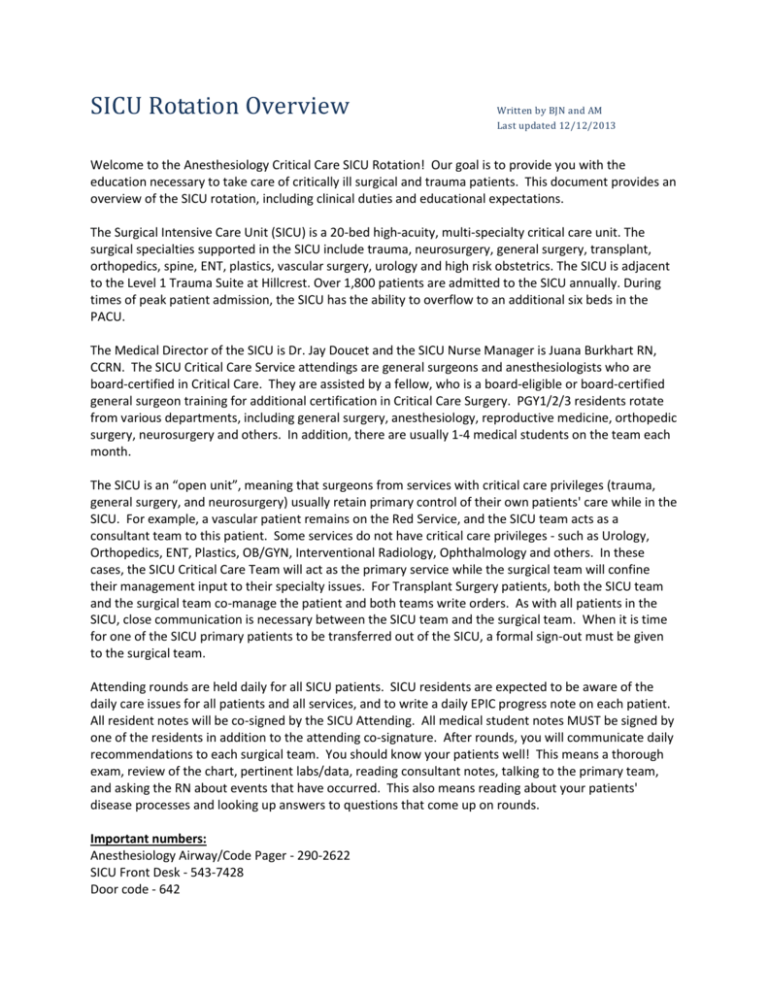
SICU Rotation Overview Written by BJN and AM Last updated 12/12/2013 Welcome to the Anesthesiology Critical Care SICU Rotation! Our goal is to provide you with the education necessary to take care of critically ill surgical and trauma patients. This document provides an overview of the SICU rotation, including clinical duties and educational expectations. The Surgical Intensive Care Unit (SICU) is a 20-bed high-acuity, multi-specialty critical care unit. The surgical specialties supported in the SICU include trauma, neurosurgery, general surgery, transplant, orthopedics, spine, ENT, plastics, vascular surgery, urology and high risk obstetrics. The SICU is adjacent to the Level 1 Trauma Suite at Hillcrest. Over 1,800 patients are admitted to the SICU annually. During times of peak patient admission, the SICU has the ability to overflow to an additional six beds in the PACU. The Medical Director of the SICU is Dr. Jay Doucet and the SICU Nurse Manager is Juana Burkhart RN, CCRN. The SICU Critical Care Service attendings are general surgeons and anesthesiologists who are board-certified in Critical Care. They are assisted by a fellow, who is a board-eligible or board-certified general surgeon training for additional certification in Critical Care Surgery. PGY1/2/3 residents rotate from various departments, including general surgery, anesthesiology, reproductive medicine, orthopedic surgery, neurosurgery and others. In addition, there are usually 1-4 medical students on the team each month. The SICU is an “open unit”, meaning that surgeons from services with critical care privileges (trauma, general surgery, and neurosurgery) usually retain primary control of their own patients' care while in the SICU. For example, a vascular patient remains on the Red Service, and the SICU team acts as a consultant team to this patient. Some services do not have critical care privileges - such as Urology, Orthopedics, ENT, Plastics, OB/GYN, Interventional Radiology, Ophthalmology and others. In these cases, the SICU Critical Care Team will act as the primary service while the surgical team will confine their management input to their specialty issues. For Transplant Surgery patients, both the SICU team and the surgical team co-manage the patient and both teams write orders. As with all patients in the SICU, close communication is necessary between the SICU team and the surgical team. When it is time for one of the SICU primary patients to be transferred out of the SICU, a formal sign-out must be given to the surgical team. Attending rounds are held daily for all SICU patients. SICU residents are expected to be aware of the daily care issues for all patients and all services, and to write a daily EPIC progress note on each patient. All resident notes will be co-signed by the SICU Attending. All medical student notes MUST be signed by one of the residents in addition to the attending co-signature. After rounds, you will communicate daily recommendations to each surgical team. You should know your patients well! This means a thorough exam, review of the chart, pertinent labs/data, reading consultant notes, talking to the primary team, and asking the RN about events that have occurred. This also means reading about your patients' disease processes and looking up answers to questions that come up on rounds. Important numbers: Anesthesiology Airway/Code Pager - 290-2622 SICU Front Desk - 543-7428 Door code - 642 Main OR front desk - 543-6040 Scheduled Daily Activities 0600-0815: 0815-0830: 0830-0900: 0900-1100: 1100-1200: Pre-round with communication/input from primary teams Assemble rounds materials +/- review with SICU Fellow Radiology rounds at the PACS monitor Bedside rounds on all SICU patients Daily SICU Didactic Conference, except weekends After rounds and conference, the following should occur: - Completion of notes (including signing the medical student notes) - Communicate all recommendations to the primary surgical teams - Carry out management plans on SICU team "primary" patients, including any procedures to be done - Assure that your patients are stable - Sign out your patients to the On-call SICU Resident (more detailed sign-out on "primary" patients) - When these duties are completed, the Residents who are NOT on-call may leave the hospital (typically early to mid-afternoon) Note about POST-CALL PGY2/3 residents: Each attending/fellow will have their own strategy for when the post-call resident is to be relieved, but In order to comply with ACGME standards, you must leave the hospital after 28 hours max. This usually means by 10am on your post-call day. Note that this does not apply to interns (PGY1) who do 16 hour max shifts. Anesthesiology SICU Resident Roles/Responsibilities: 1. Respond to Emergency Airway management needs – carry code pager (x2622) a. This is the emergency pager which is called for Airway/Respiratory/Cardiac Arrest anywhere in the hospital and in the Trauma Resuscitation Suite (Trauma Bay). b. OR Resuscitation is also called on this pager (OR 11). c. This pager is only carried by Anesthesiology residents (not surgical residents). d. When you accept the pager, it is your responsibility to assure the code bags are fully stocked. e. When you respond to a code situation and the patient is already intubated, it is YOUR responsibility to make sure the ETT is correctly positioned in the trachea. f. Once the airway is secured, you may assist with vascular access and other needs during a code. Always check with the code leader before leaving. 2. Participate in SICU Rounds a. Pre-round and be prepared to present your patients on rounds. b. Complete notes using EPIC template (“MYSICU”) c. Use a systems-based approach for presentation followed by assessment and thoughtful plan. d. Have knowledge of all primary and consultant patients (described further below). e. Always include the bedside RN in daily rounds. 3. Wednesday M&M/Grand Rounds conference a. Residents are required to attend 0630 Wednesday morning Grand Rounds. If for some reason you are unable to go, you should let Anush know why. i. Surgery residents also have their Grand Rounds conference on Wednesday mornings. ii. Every Tuesday, the plan for Wed morning rounds should be discussed so that both the Anesthesia and Surgery residents can attend their Grand Rounds. iii. The SICU service attending may delay rounds to allow attendance. iv. The option also remains to not include the Trauma-Critical Care patients on rounds given they have a critical care service caring for them (but this needs to be determined by the SICU Attending). 4. Primary versus Consultant ICU Management a. It is important to note that you should know all SICU patients well enough to be the primary medical service. However, there are certainly some differences in responsibilities depending on the SICU team's role in each patient's ICU management. b. Primary Service – Services such as OB/GYN, Head and Neck Surgery, Plastics, Orthopedics, Orthopedic Spine, Urology, Liver/Renal Transplant Surgery; often referred to as our "primaries" i. The SICU team is primarily responsible for these patients’ care. ii. The SICU team will write all necessary orders for these patients. iii. The SICU team is responsible for communicating all ongoing management decisions/orders to the surgical service. c. Consultant Service – Trauma, Neurosurgery, White Surgery (Acute Care Surgery), other general surgery services i. The SICU team will round on these patients and write a SICU progress note each day. ii. All recommendations will be communicated directly to the primary team. iii. During normal daily hours, the SICU team will not write any orders on these patients except in the case of an emergency. At night, however, the SICU team may be cross-covering some of these patients (see #5 below). 5. On-Call SICU Responsibilities a. During on-call hours (usually after 5pm), the SICU Anesthesiology Resident is responsible for ICU management for all patients in the SICU except Trauma and Neurosurgery. This means any of the general surgery services in addition to our “primary” patients. i. Sign out must occur from the primary surgery service to the SICU resident assuming responsibility. You should not assume primary responsibility until you have received a sign-out. ii. At night, you will write orders and manage these patients as if you were the primary team. iii. There is always a senior surgery resident and a Trauma fellow/attending in the hospital if you need any assistance. iv. The SICU attending is always available by phone for help and can return to the hospital if necessary. b. You should call the on call in-house Anesthesiology attending (and/or upper level residents) for airways and codes. Do not go to these emergencies alone. c. If Trauma and neurosurgery are very busy, it is possible that they will ask for your help in writing orders and placing invasive venous and arterial lines. d. OR 7 and 11 setup and OR Resuscitations i. See attached OR 7 and 11 checklists. The MOR residents should help with setup, but YOU have the ultimate responsibility for these rooms being ready to go. ii. You should be the primary Anesthesia provider in the case of an OR Resuscitation in OR 11. e. If you have down time while on-call, there is a lot that can be learned by hanging out in the Trauma Bay and observing/helping with management of trauma patients. Didactics: There will be a formal didactic conference each weekday from 11am-12pm. These conferences will vary based on each attending. Sometimes the attending or fellow will lead the discussion, other times there will be a presentation by one of the residents or medical students followed by discussion. On Fridays, the Pharmacy team usually gives a presentation. Conference location: Trauma conference room across hall from SICU. Door code 4-2-enter Core Critical Care Topics: These should be reviewed either formally or informally during your rotation. Shock Mechanical Ventilation Weaning from MV ARDS SIRS, Sepsis, MODS Hemodynamic Monitoring Head Injury and ICP Management Neurological Illness and Critical Care Electrolyte and Acid-Base Abnormalities Renal Failure Hepatic Failure Use of Blood Products in the ICU Coagulation Disorders DVT Prophylaxis, PE Infectious Disease and Antibiotics Nutritional Assessment and Support Vasoactive Drugs Analgesia, Sedation, Paralysis Hypertensive Crisis ACLS Protocols Gastrointestinal Hemorrhage and Prophylaxis Procedures: Consent is required from the family member, or from the surrogate decision maker for all procedures which are not emergent in nature (e.g. central lines, PA catheters, arterial lines, dialysis lines, and bronchoscopy). After a procedure, a note is entered into EPIC with the attending selected as the cosigner for billing purposes. To do this, the resident must first place the order in epic, for placement of a line, or bronchoscopy, etc. The order is then signed. After the procedure, the rounding-consult tab is selected and the ‘procedure notes’ is selected. The order is then highlighted for the procedure done. Click on “document order” and fill out the template as appropriate. Strict sterile precautions are mandatory for all arterial and central lines placed in the SICU (unless truly emergent). This includes washing hands, gown, hat, mask, sterile gloves, full drape, skin prep with chlorhexidine. Professionalism: Residents are expected to maintain a high degree of professionalism when interacting with other members of the SICU team, nurses, patients, family members, other surgical teams, and all ancillary staff. Occasionally there will be differing opinions in terms of patient care or in terms of daily routines. One of the greatest skills you can take away from this ICU month is the refined ability to communicate professionally, respect others' opinions, and learn to be an effective consultant (which will be absolutely crucial to your future career as an Anesthesiologist). Remember that you represent the Anesthesiology Critical Care Medicine division in addition to the entire Dept of Anesthesiology, and that you are a role model for medical students. Many critically-ill patients are depending on all of us to work in harmony in order to provide them with the best possible care. Be the person who is a positive leader with a good attitude and this will benefit you long after your SICU month is over. Reading Materials and other information: Books (we have copies in the Anesthesia Resident Lounge): 1. Marino PL, Sutin KM. The ICU Book. Lippincott Williams & Wilkins 2007. (also available online) 2. Wilson WC, Grande CM, Hoyt DB, eds. Trauma: Critical Care. Informa Healthcare 2007. “Introduction to Critical Care” written by Beverly J. Newhouse, MD, pdf version from J.M. Ehrenfeld et al. (eds.), Anesthesia Student Survival Guide: A Case-Based Approach, Springer Science+Business Media, LLC 2010. There will be papers referred to and given to you by individual attendings or fellows. Website: http://www.ccmtutorials.com is an excellent website developed by the Society of Critical Care Medicine to assist residents in learning critical care. SICU Faculty: You should feel free to contact any of the ACCM faculty with questions/concerns. In addition to the Attending on-service, your point faculty are Anush and Bev for questions about the rotation, issues that arise, and revisions to this document so that it can be appropriately updated for future residents. We look forward to working with you and hope that this will be a valuable experience for each of you! Anesthesiology Critical Care Faculty Dr. Anush Minokadeh, Director of Anes-Critical Care and ACCM Fellowship Dr. Beverly Newhouse, Associate Director of Anes-Critical Care, Residency Education Director Dr. Erik Kistler, Director of ACCM Research Dr. Kimberly Robbins, Associate Director of ACCM Fellowship Dr. E. Orestes O'Brien, Director of Critical Care Echocardiography Dr. Zeb McMillan, Director of ACCM Journal Club Anesthesiology SICU Rotation Coordinator - Julie Nguyen or Karen Bradley jungyuen@ucsd.edu or anesresidency@ucsd.edu Surgical Critical Care Faculty Dr. Jay Doucet, Director of SICU Dr. Raul Coimbra, Chief of Trauma Dr. Vishal Bansal Dr. Leslie Kobayashi Dr. Todd Costantini Other Trauma Surgery (and Burn) Faculty Dr. Jeanne Lee Dr. Bruce Potenza
